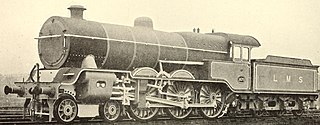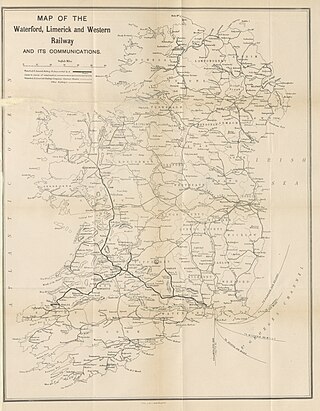
The Lancashire and Yorkshire Railway (L&YR) was a major British railway company before the 1923 Grouping. It was incorporated in 1847 from an amalgamation of several existing railways. It was the third-largest railway system based in northern England.
George Hughes was an English locomotive engineer, and chief mechanical engineer (CME) of the Lancashire and Yorkshire Railway (L&YR) and the London, Midland and Scottish Railway (LMS).
The Lancashire and Yorkshire Railway (LYR) built suburban electric stock for lines in Liverpool and Manchester. The line between Liverpool to Southport began using electric multiple units (EMUs) on 22 March 1904, using a third rail 625 V DC. Additional trains were later built for this route, and in 1913 incompatible stock for the route to Ormskirk. Lightweight units were built to run on the Liverpool Overhead Railway.

The Liverpool, Crosby and Southport Railway was a British railway company, which opened a line in 1848 between Southport and Waterloo, extending into Liverpool in 1850. The company was acquired by the Lancashire and Yorkshire Railway in 1855. The line is still open.
The East Lancashire Railway operated from 1844 to 1859 in the historic county of Lancashire, England. It began as a railway from Clifton via Bury to Rawtenstall, and during its short life grew into a complex network of lines connecting towns and cities including Liverpool, Manchester, Salford, Preston, Burnley and Blackburn.
Manchester United Football Club was formed in 1878 as Newton Heath LYR Football Club by the Carriage and Wagon department of the Lancashire and Yorkshire Railway depot at Newton Heath. The team initially played games against other departments and rail companies at their home ground at North Road, but by 1888 the club had become a founding member of The Combination, a regional football league. However, following the league's dissolution before the end of its first season, Newton Heath joined the newly formed Football Alliance, which ran for three seasons before being merged with The Football League. This resulted in the club starting the 1892–93 season in the First Division, by which time it had become independent of the rail company, dropped the "LYR" from its name and moved to a new ground at Bank Street. After just two seasons, the club was relegated to the Second Division.
William Barton Wright was an English mechanical engineer, also tea plantation owner and mine owner. He was Locomotive Superintendent of the Lancashire and Yorkshire Railway (LYR) from 1875. During his ten-year career in that post he helped to make the LYR one of the most efficient railways in the United Kingdom, by designing a range of good locomotives to haul the LYR's traffic.

Horwich Works was a railway works built in 1886 by the Lancashire and Yorkshire Railway (LYR) in Horwich, near Bolton, in North West England when the company moved from its original works at Miles Platting, Manchester.

North Road was a football and cricket ground in Newton Heath, Manchester, England. It was the first home of Manchester United Football Club – then known as Newton Heath Lancashire & Yorkshire Railway Football Club – from its foundation in 1878 until 1893, when the club moved to a new ground at Bank Street, Clayton.

John Chester Craven was an English locomotive engineer. He was the locomotive, carriage and wagon superintendent of the London, Brighton and South Coast Railway from 1847 until his resignation in 1870. He died in 1887.

Britannia railway station served Britannia near Bacup, Lancashire, England, from 1881 until closure in 1917. The station was just to the west of the summit of the line, which was also the highest point on the entire Lancashire and Yorkshire Railway (LYR) system.

The Lancashire and Yorkshire Railway (L&YR) Class 8 was a four-cylinder 4-6-0 express passenger locomotive designed by George Hughes introduced in 1908.
Thomas Burke (1863–1914) was a Welsh international footballer who played for Wrexham Olympic and Newton Heath LYR. Burke won a total of eight caps for Wales, playing at half-back.

The Waterford, Limerick and Western Railway (WL&WR), formerly the Waterford and Limerick Railway up to 1896, was at the time it was amalgamated with the Great Southern and Western Railway in 1901 the fourth largest railway in Ireland, with a main line stretching from Limerick to Waterford and branches to Sligo and Tralee.
The Lancashire and Yorkshire Railway (L&YR) operated two classes of twenty steam railmotors in total.
The L&YR Class 2 (Aspinall) was a class of 4-4-0 steam locomotives of the Lancashire and Yorkshire Railway.

Newton Heath TMD is a traction maintenance depot in Newton Heath, Manchester, England, at the junction of the Calder Valley Line and the former Oldham Loop Line 2+1⁄4 mi (3.6 km) east of Manchester Victoria station.
Martin Atock, also formerly known as Martin Attock, was an English railway engineer, who is best known as the Locomotive Superintendent of the Midland Great Western Railway (MGWR) from 1872 to 1900.

The Lancashire and Yorkshire Railway (L&YR) Barton Wright 4-4-0 was four-coupled eight-wheeled bogie express engine which entered service in 1880.
William Fernihough was locomotive superintendent of the Eastern Counties Railway (ECR) from 1843 to 1845. He is noted for his work on the balancing of railway engines in particular the counterbalanced driving wheel










